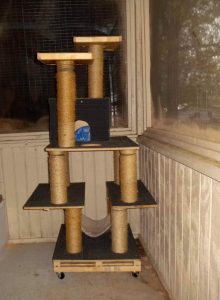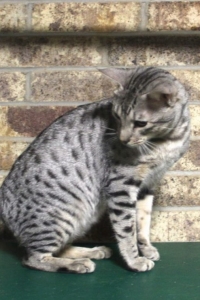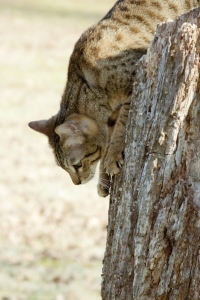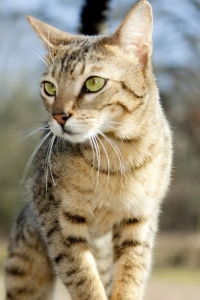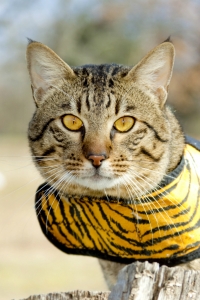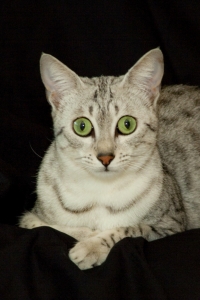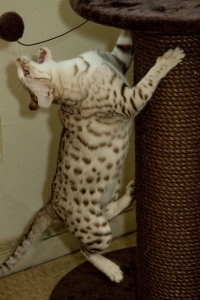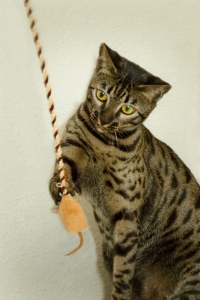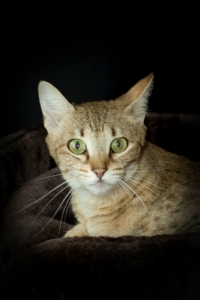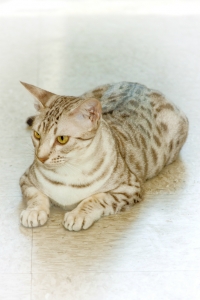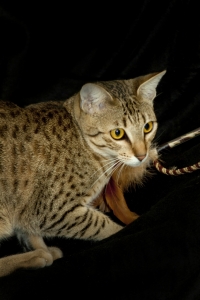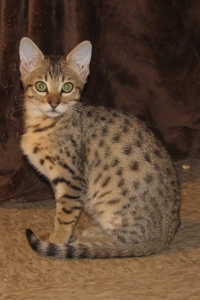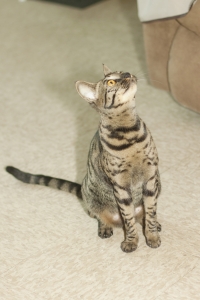
The Facts About Declawing Your Cat or Kitten
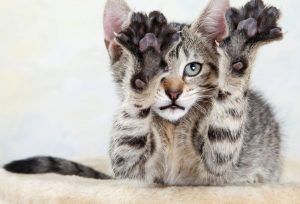 Choosing to declaw your cat is a big decision. Before you make it, you should ensure that you have all the facts. Think about what this might mean for you and what it will definitely mean for your cat.
Choosing to declaw your cat is a big decision. Before you make it, you should ensure that you have all the facts. Think about what this might mean for you and what it will definitely mean for your cat.
Claws are an important part of cat’s anatomy. Most mammals walk on the soles of their feet cats walk on their toes. Their entire body is engineered for toe walking; their backs, shoulders, paw and leg joints, muscles, tendons and ligaments are designed to distribute weight across the toes. Their claws are used for balance, exercise, and stretching. If a cat is stiff it sinks its claws into a surface to create an anchor for stretching. This is the only way cat can exercise its back, legs and neck muscles.
Declawing is an American Thing something people do for their convenience without realizing what happens to their beloved cat. In European countries declawing is termed inhumane and unnecessary mutilations. It is banned (illegal) in Australia, Austria, Belgium, Bosnia, Brazil, Denmark, England, Finland, France, Germany, Ireland, Israel, Italy, Japan, Malta, Macedonia, Montenegro, New Zealand, Netherlands, Northern Ireland, Norway, Portugal, Scotland, Serbia, Slovenia, Sweden, Switzerland, Wales, and the city of Denver, Colorado USA.
 Before you make the decision to declaw there are important facts – Declawing is not like a manicure (see attached picture) it’s a serious invasive surgery. Cat claws adhered to the bone to declaw the last bone of yours cat “toes” is removed you are actually having your cats first knuckle amputated. The procedure has inherent risks and complications not limited to anesthetic complications, hemorrhage, infection and severe pain. It is like cutting off each finger at the last knuckle. In fact there is so much pain, that pain management is necessary – not elective and required for this procedure.
Before you make the decision to declaw there are important facts – Declawing is not like a manicure (see attached picture) it’s a serious invasive surgery. Cat claws adhered to the bone to declaw the last bone of yours cat “toes” is removed you are actually having your cats first knuckle amputated. The procedure has inherent risks and complications not limited to anesthetic complications, hemorrhage, infection and severe pain. It is like cutting off each finger at the last knuckle. In fact there is so much pain, that pain management is necessary – not elective and required for this procedure.
 This is a very painful surgery with a painful recovery period. Cats are very prideful animal they instinctively hide pain knowing they are at risk when in weakened position. Make no mistake this pain is for the rest of their life. While recovering from the surgery your cat will use its feet to walk, jump and scratch in its litter box regardless of the pain it is experiencing. Cats are digitigrades the claws are an important part of this design. Amputation alters the conformation of their feet realigning the skeleton. This realignment possibly contributes to future litter box avoidance and health problems.
This is a very painful surgery with a painful recovery period. Cats are very prideful animal they instinctively hide pain knowing they are at risk when in weakened position. Make no mistake this pain is for the rest of their life. While recovering from the surgery your cat will use its feet to walk, jump and scratch in its litter box regardless of the pain it is experiencing. Cats are digitigrades the claws are an important part of this design. Amputation alters the conformation of their feet realigning the skeleton. This realignment possibly contributes to future litter box avoidance and health problems.
A declawed cat is deprived of its primary means of defense, leaving it open prey to predators if it ever escapes to the outdoors. Some believe the cat’s personality change after being declawed. A declawed cat can never be let outside, ever. They are defenseless
The number one reason house cats are surrender is litter box avoidance. The vast majority of these cats are declawed. Walking on litter gravel/gritty particles many declawed cats hurt causing the association of pain with litter boxes. When this happens please do not surrender you cat try using soft type litter like shredded paper and other alternatives. Remember the cat was put in this position because of the choice to declaw. It’s is totally unfair to surrender the cat because of a problem his/her owner created. The procedure of declawing is not necessary. You probably heard horror stories however cats can learn by training where they can scratch and where they can’t. For ideas and resource reference please read the scratch alternative section of this blog.
After the procedure of Declawing
While not every cat will experience any effects once healed from the surgery there are some things to watch for
- Back and joint problems. Removal of the claws means removal of a cat’s ability to stretch its back muscles and changes the way in which the feet hit the ground. This can lead to back problems, including pain and muscle atrophy. Think of it like wearing improper shoes in humans.
- Pain. Declawing can be very painful. Pain is only the first of these problems while rare some long-term lasting physical problemsincludes re-growth of deformed claws inside the paw, bone spurs, nerve damage, lameness, infections and hemorrhage (loss of blood).
- Litter box problems. After de-clawing cats will have really tender paws and cat litter won’t feel very good to walk on. As a result, some cats may associate the litter box with pain and refuse to use the litter box. It is recommended that pet-owners provide a paper-only litter box option immediately following surgery to avoid this problem. . Poor pain management can make your cat wary of using the litter box
- Personality changes. Some cats’ personality and behaviors are changed by de-clawing. They can become more nervous or fearful than they were before, and this can lead to aggression. No longer able to use their claws to mark de-clawed cats sometimes result to spraying urine instead. Some become more aggressive and start biting and chewing shredding material like curtains and blankets.
- De-clawed cats can’t go outside, ever. Declawing is the removal of a cat’s first line of defense. For indoor cats, this can mean a greater dependence on their teeth, but for outdoor cats, this is endangerment. Once you’ve declawed a cat, they should stay indoors to stay safe from predators. They cannot climb trees to escape danger or use they claw for protection from other cats (feral). De-Clawed cats should remain in the house for the rest of their lives.
 Scratching Alternatives
Scratching Alternatives
There are ways to train your cat not to scratch at your furniture using scratching poles and aversion methods. Strategically locating your scratching poles and cat trees will encourage usage. We build our cat trees wrapping sisal tightly around the full length of each post. Our cats love these scratching post. Although you may need to train your cat most will use the sisal post without training. Our cats instantly preferred the sisal wrapped post to scratch opposed to other objects. Using floor mats is another good scratch attractant for cats. We buy carpet squares with rubber backing from Atwood’s for 99 cents; Wal-Mart and most pet stores sell sisal mats. Cats love to sink their claws in the mats to scratch and trim. Remember LOCATION is very important for cat trees, scratching post. Scratching mats and litter boxes.
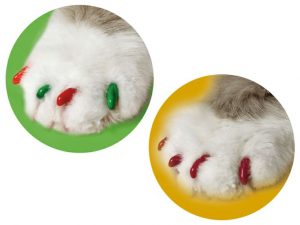 Soft Paws is a good stand along scratching solution. It can be used with the other choices previous described. Soft Paws are lightweight vinyl nail caps that you glue on the cat’s front claws. They even come in fun colors if you’re up to the cat manicure! The nail caps stay on for about 4 to 6 weeks and fall off with the natural growth of the cat’s nails. Soft Paws are easy to apply and last about 4 to 6 weeks.
Soft Paws is a good stand along scratching solution. It can be used with the other choices previous described. Soft Paws are lightweight vinyl nail caps that you glue on the cat’s front claws. They even come in fun colors if you’re up to the cat manicure! The nail caps stay on for about 4 to 6 weeks and fall off with the natural growth of the cat’s nails. Soft Paws are easy to apply and last about 4 to 6 weeks.
Perhaps one of the most important furniture scratching prevention is trimming your cat claws about every 2 to 3 weeks. The reason Cats’ scratch is to trim and sharpen their claws. Regular trimming deceases the frequency of scratching .

